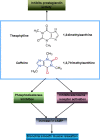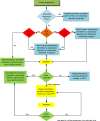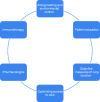Asthma in children and adolescents: a comprehensive approach to diagnosis and management
- PMID: 22187333
- PMCID: PMC7091307
- DOI: 10.1007/s12016-011-8261-3
Asthma in children and adolescents: a comprehensive approach to diagnosis and management
Abstract
Asthma is a chronic disease that has a significant impact on quality of life and is particularly important in children and adolescents, in part due to the higher incidence of allergies in children. The incidence of asthma has increased dramatically during this time period, with the highest increases in the urban areas of developed countries. It seems that the incidence in developing countries may follow this trend as well. While our knowledge of the pathophysiology of asthma and the available of newer, safer medication have both improved, the mortality of the disease has undergone an overall increase in the past 30 years. Asthma treatment goals in children include decreasing mortality and improving quality of life. Specific treatment goals include but are not limited to decreasing inflammation, improving lung function, decreasing clinical symptoms, reducing hospital stays and emergency department visits, reducing work or school absences, and reducing the need for rescue medications. Non-pharmacological management strategies include allergen avoidance, environmental evaluation for allergens and irritants, patient education, allergy testing, regular monitoring of lung function, and the use of asthma management plans, asthma control tests, peak flow meters, and asthma diaries. Achieving asthma treatment goals reduces direct and indirect costs of asthma and is economically cost-effective. Treatment in children presents unique challenges in diagnosis and management. Challenges in diagnosis include consideration of other diseases such as viral respiratory illnesses or vocal cord dysfunction. Challenges in management include evaluation of the child's ability to use inhalers and peak flow meters and the management of exercise-induced asthma.
Figures
















References
-
- Pearce N, Douwes J. The global epidemiology of asthma in children. Int J Tuberc Lung Dis. 2006;10:125–132. - PubMed
-
- Bateman ED, Hurd SS, Barnes PJ, et al. Global strategy for asthma management and prevention: GINA executive summary. Eur Respir J. 2008;31:143–178. - PubMed
-
- New NHLBI. Guidelines for the diagnosis and management of asthma. National Heart, Lung and Blood Institute. Lippincott Health Promot Lett. 1997;2(1):8–9. - PubMed
-
- Expert Panel Report 3 (EPR-3) Guidelines for the diagnosis and management of asthma-summary report 2007. J Allergy Clin Immunol. 2007;120:S94–S138. - PubMed
-
- Priftis KN, Mantzouranis EC, Anthracopoulos MB. Asthma symptoms and airway narrowing in children growing up in an urban versus rural environment. J Asthma. 2009;46:244–251. - PubMed
Publication types
MeSH terms
Substances
LinkOut - more resources
Full Text Sources
Medical
Miscellaneous

